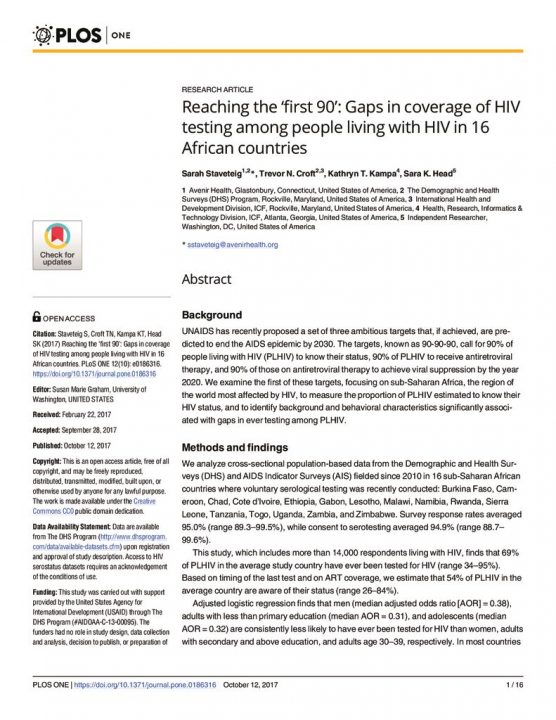
Reaching the First 90: Gaps in coverage of HIV testing among people living with HIV in 16 African countries
Summary
UNAIDS has recently proposed a set of three ambitious targets that, if achieved, are predicted to end the AIDS epidemic by 2030. The targets, known as 90-90-90, call for 90% of people living with HIV (PLHIV) to know their status, 90% of PLHIV to receive antiretroviral therapy, and 90% of those on antiretroviral therapy to achieve viral suppression by the year 2020. We examine the first of these targets, focusing on sub-Saharan Africa, the region of the world most affected by HIV, to measure the proportion of PLHIV estimated to know their HIV status, and to identify background and behavioral characteristics significantly associated with gaps in ever testing among PLHIV.
Methods and findings
We analyze cross-sectional population-based data from the Demographic and Health Surveys (DHS) and AIDS Indicator Surveys (AIS) fielded since 2010 in 16 sub-Saharan African countries where voluntary serological testing was recently conducted: Burkina Faso, Cameroon, Chad, Cote d’Ivoire, Ethiopia, Gabon, Lesotho, Malawi, Namibia, Rwanda, Sierra Leone, Tanzania, Togo, Uganda, Zambia, and Zimbabwe. Survey response rates averaged 95.0% (range 89.3–99.5%), while consent to serotesting averaged 94.9% (range 88.7–99.6%).This study, which includes more than 14,000 respondents living with HIV, finds that 69% of PLHIV in the average study country have ever been tested for HIV (range 34–95%). Based on timing of the last test and on ART coverage, we estimate that 54% of PLHIV in the average country are aware of their status (range 26–84%).Adjusted logistic regression finds that men (median adjusted odds ratio [AOR] = 0.38), adults with less than primary education (median AOR = 0.31), and adolescents (median AOR = 0.32) are consistently less likely to have ever been tested for HIV than women, adults with secondary and above education, and adults age 30–39, respectively. In most countries, unadjusted logistic regression also finds significant gaps in testing among the poorest groups and those reporting never having had sex.
Conclusion
The fact that an average of 54% of PLHIV in these 16 countries are estimated to know their status reflects encouraging progress. However, not only is this average far short of the 90% target set by UNAIDS for 2020, but it also implies that in the average study country nearly one-half of PLHIV are unable to access lifesaving care and treatment because they are unaware that they are HIV-positive.Several gaps in HIV testing coverage exist, particularly among adolescents, the least educated, and men. While the need to target demographic groups at greatest risk of HIV continues, additional interventions focused on reaching men and on reaching socially vulnerable populations such as adolescents, the poorest, and the least educated are essential.
